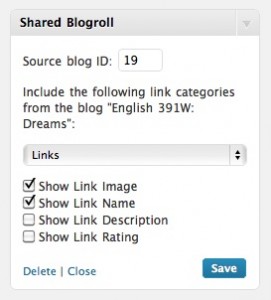Last week, in the post where I announced my new WPMU plugin Shared Blogroll, I briefly mentioned the use case that I had in mind, which was of course education-focused. Yesterday and today I did some more work on the plugin itself (MORE AJAX 4EVA) and some of the supporting players. I thought I’d spell it out a little more so that others could implement what is probably the coolest system for shared blogrolls on earth, or at least on WPMU, which amounts to pretty much the same thing.
The plugins
- Shared Blogroll. This creates a widget that allows bloggers to embed a link category from any other blog on the system on their own blog.
- Add Users Sidebar Widget. This plugin is already pretty great, as well it should be seeing as it’s written by good-looking Canadians. I made some edits to the plugin to make it a bit more flexible.
- First I removed the RSS box from the Add User widget. For most of my users, it’ll confuse; for all of them, it’ll be redundant, since they’ll all be using Wordpress blogs and thus will have feeds that are very auto-discoverable.
- As the plugin stands in the repository, links are automatically put into the blog’s default link category (or, if they’re using FeedWordPress, the FWP link category). For most users, that’s something unhelpful like “Links” or “Uncategorized”. I altered the plugin so that the blog owner can choose which link category the added links will be put into. As I’ll discuss below, I think that this will add a lot of flexibility to the way that the plugins can be used together. You can download the text of my modified version of Add Users Sidebar Widget here: add-link-sidebar-widget.txt. Save as .php before uploading – and make sure that you uninstall previous versions of the plugin before uploading, or you might get whitescreened to death.
- Optional step. The default WP Links widget is set up so that you can’t select to display an empty category of links. As you’ll see below, I want to have instructors create a new category for their blogrolls, and I figured it’d be pretty confusing if they couldn’t create a sidebar widget corresponding to a link category until at least one student had posted a link (thus populating the category). So I wrote a little plugin that replaces the default Links widget with one that allows you to pick an empty links category. Drop this into mu-plugins: link_widget_allow_empty_cat. Be warned, though, that this plugin deregisters the default Links widget, which might have the effect of removing every links widget on your installation of WPMU. (I haven’t tested it.) For me, it’s OK, because I don’t have any active users yet. As an alternative, you could edit the core of WP (making sure to back up, take note of where you made the edit for future upgrades, blah blah blah) in the following way. In wp-includes/default-widgets.php, line 139 reads [code language=”php”]$link_cats = get_terms( ‘link_category’);[/code] Replace it with [code language=”php”]$link_cats = get_terms( ‘link_category’, ‘hide_empty=0’);[/code] That should leave all of your pre-existing links widgets in place.
The process
The immediate goal of this setup is to allow a class blogroll to be shared effortlessly between members of a class. (Though I can imagine lots of other very cool uses.) Here are the directions I’m going to give to instructors and students on how to leverage these two plugins to make it happen.
Instructors
- Create a new Link Category for your class blogroll – let’s say you call it “ENG 110 Blogroll”.
- Add a Links widget to the sidebar, making sure to select “ENG 110 Blogroll” from the category dropdown.
- Add an Add Links widget to the sidebar. Again, be sure to select “ENG 110” blogroll as the target category for added links.
- Give your blog’s ID number to your students and give them the following directions.
Students
- After creating a blog, visit the professor’s blog and enter your site’s URL into the Add Link sidebar widget.
- Add a Shared Blogroll widget to your own blog’s sidebar. Enter the professor’s blog ID number as the source blog, select “ENG 110 Blogroll” from the dropdown list, and Save.
I hope that the instructors and students get into this blogroll sharing thing. It distributes what would otherwise be a huge amount of work for the instructor, or *worse yet*, for me.
